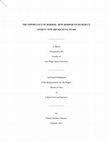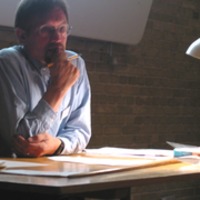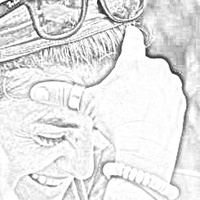Papers by Patrick Johnson

It has been said that fear is one of the most powerful and ancient emotions in the human race. ... more It has been said that fear is one of the most powerful and ancient emotions in the human race. It should come as no surprise then that horror as an art form has existed for centuries. Throughout history horror has let humans externalize their fears. It is my conjecture that the artists who make horror films and literature have, unintentionally, found a way to let people expose themselves to their very real fears by means of sophisticated metaphors. The aim of this study was twofold. First, I sought to demonstrate that horror is a reflection of the fears of the society and culture in which it was created. Secondly, I intend to show that it acts as a sort of subconscious, prolonged exposure that helps people deal with their societal fears.
This study contained two main elements to test this hypothesis. The first is that participants monitored their fear levels in vivo while watching scenes from six different horror films. This was to test to see, first, if there was indeed an increase in fear from the start to the end and, second, if the end of each clip would result in a decrease in fear. This would indicate that the participants experienced some type of relief from their fear. The second element is that the participants were asked to retrospectively explain what made each scene scary. This was left vague to prevent influencing the answers, but the goal was to see if participants were relating these horror scenes with the real life fears that are represented in each of the films.
The participants not only experienced a sense of relief at the end of each scene, but there was also some indication in the case of The Crazies that this may be because people are associating the film with real life fears. This study has shown that those who watch horror experience a type of relief after each scene, even if that scene does not bring about relief on its own. This is because horror is not an emotion that can be sustained during prolonged exposure. If viewers experienced a decline in horror after only 10 minutes in each scene, it is logical to assume that the decline would be even greater after the entire film was over. If audiences are experiencing this relief in the theater, it is also logical that they are experiencing this relief in their everyday lives.

Masculinity has traditionally been considered to be the opposite of femininity and, thusly, has o... more Masculinity has traditionally been considered to be the opposite of femininity and, thusly, has often been perceived and portrayed as belonging strictly to heterosexual males. Historically, one of the main propagating sources of this ideology has been the media, and, in particular, advertising. Niche marketing ironically reveals nuances and diversity in Latino men’s experiences that are often ignored in the social sciences. Indeed, social science literature tends to subsume Latino men’s experiences under the category of “machismo,” a concept developed in U.S. academic circles during the 1970s to suggest that Latino men are more sexist than other men and that Latina women are more oppressed than other women. The primary aim of this study is to reexamine the “traditional” and widely-held ideology of what masculinity is. This research will compare the portrayals of men (e.g., body language, skin color, body types, clothing, situations) in advertisements in six Latina/o magazines that are targeted at Latinas/os living in the United States. The study will look at advertisements in magazines that are geared towards women (Latina and Mujer), heterosexually-identified men (Latino and Urban Latino), and gay-identified men (Ambiente and QVMagazine). I hypothesize that these media sources will demonstrate that masculinity exists on a spectrum that intersects with race, class, and consumer society, thusly helping break down the borders that have been placed around the idea of masculinity.

Past literature on self-fashioning has demonstrated that popular forms of entertainment have been... more Past literature on self-fashioning has demonstrated that popular forms of entertainment have been able to shape how members of society behave. In the past, these forms of entertainment have ranged from symposiums during Ancient Greece to theater during the Renaissance. Nowadays, with the average American household having over two televisions, the most prevalent form of pop culture is arguably television, and even more specifically sitcoms and reality shows. Even though the sitcom has been predicted to be on the verge of dying for almost 20 years, it has nevertheless remained a staple of the primetime schedules on every major broadcast television network. Extant literature about and episodes of television shows such as Seinfeld, Friends, Roseanne, How I Met Your Mother, Community, and The Osbournes were reviewed for content, character development, and impact upon portions of society. All of these shows illustrated how influential television is on the general public and how, by attempting to reflect what is typical in modern society, the sitcom, as with other forms of popular culture in the past, creates norms and shows people how to pursue relative happiness in life. It is for this reason that sitcoms should not merely be disregarded as pure entertainment, but be understood to have a significant impact on the way many Americans view themselves in relationship to our society.

It has the power to change the way people think. Its leaders have the ability to sway elections. ... more It has the power to change the way people think. Its leaders have the ability to sway elections. It has become one of the most dominant forces in American life today. Of course what I am referring to is popular music. Music has been around for hundreds of thousands of centuries, probably dating as far back to almost the beginning of the Earth. Throughout recent decades, the influence of music and musicians has been of worthy of serious postulation and consideration. Music helped divide cultures. Music helped bring people together. Music helped bring about social change and was the voice for many during times of hardship. Musicians have used music to preach their own gospels to the masses. Musicians, when their lives get cut short, also have the power to become martyrs in their death for their cause. Using the music and lives of Jerry Garcia, John Lennon, Madonna, and Lady Gaga, I will demonstrate how to many people popular, secular music has taken the place of religion and has in fact become its own religion.
Talks by Patrick Johnson











Uploads
Papers by Patrick Johnson
This study contained two main elements to test this hypothesis. The first is that participants monitored their fear levels in vivo while watching scenes from six different horror films. This was to test to see, first, if there was indeed an increase in fear from the start to the end and, second, if the end of each clip would result in a decrease in fear. This would indicate that the participants experienced some type of relief from their fear. The second element is that the participants were asked to retrospectively explain what made each scene scary. This was left vague to prevent influencing the answers, but the goal was to see if participants were relating these horror scenes with the real life fears that are represented in each of the films.
The participants not only experienced a sense of relief at the end of each scene, but there was also some indication in the case of The Crazies that this may be because people are associating the film with real life fears. This study has shown that those who watch horror experience a type of relief after each scene, even if that scene does not bring about relief on its own. This is because horror is not an emotion that can be sustained during prolonged exposure. If viewers experienced a decline in horror after only 10 minutes in each scene, it is logical to assume that the decline would be even greater after the entire film was over. If audiences are experiencing this relief in the theater, it is also logical that they are experiencing this relief in their everyday lives.
Talks by Patrick Johnson
This study contained two main elements to test this hypothesis. The first is that participants monitored their fear levels in vivo while watching scenes from six different horror films. This was to test to see, first, if there was indeed an increase in fear from the start to the end and, second, if the end of each clip would result in a decrease in fear. This would indicate that the participants experienced some type of relief from their fear. The second element is that the participants were asked to retrospectively explain what made each scene scary. This was left vague to prevent influencing the answers, but the goal was to see if participants were relating these horror scenes with the real life fears that are represented in each of the films.
The participants not only experienced a sense of relief at the end of each scene, but there was also some indication in the case of The Crazies that this may be because people are associating the film with real life fears. This study has shown that those who watch horror experience a type of relief after each scene, even if that scene does not bring about relief on its own. This is because horror is not an emotion that can be sustained during prolonged exposure. If viewers experienced a decline in horror after only 10 minutes in each scene, it is logical to assume that the decline would be even greater after the entire film was over. If audiences are experiencing this relief in the theater, it is also logical that they are experiencing this relief in their everyday lives.